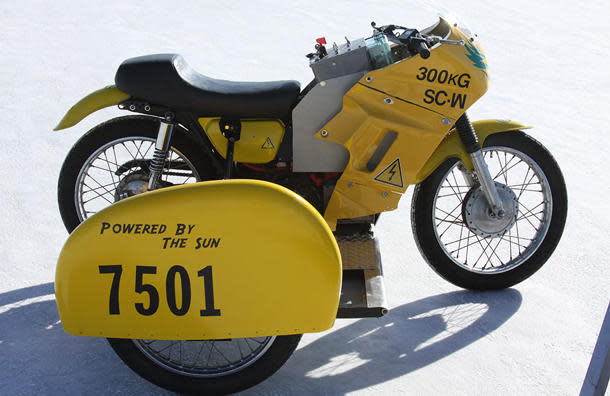 Motoramic
MotoramicSetting Bonneville speed records with three wheels, batteries and the sun: Motoramic Experts
Kevin Clemens is an award-winning journalist and author. Trained as an engineer, he has worked as a research scientist, a designer of racing and sports car tires, a public relations counselor and has been an editor and contributor at some of the transportation industry’s most influential magazines. His history-based adventures have included driving a 1959 Mercedes around the world, a Buick through the wilds of South America, a 1929 Chrysler from Beijing to Paris, and setting Land Speed Records on electric motorcycles he builds in his shop in Lake Elmo, Minn. — Ed.
In 2011, my wife and I dragged a little electric motorcycle that I had built from a 1970s Honda Scrambler out to the Bonneville Salt Flats and came home with an American Motorcycle Association (AMA) national record at the blistering speed of 61.538 mph. It was fun, but turned out to be addictive. I had caught Salt Fever.
Back to the salt again in 2012, my new bike was based on a 2004 Kawasaki Ninja 250, used high-tech lithium polymer batteries, a motor controller provided by Alltrax, Inc. and a lightweight 30kW Agni motor manufactured in India. I competed for records recognized by the Fèdèration Internationale de Motocyclisme (F.I.M.) in the 150-kg unstreamlined and partially streamlined classes and set four world records and two national records. The fastest speed on my machine was 85.7 mph, and my fastest F.I.M. record was 78.4 mph for a two way average over the salt. True, a stock Zero S electric motorcycle could better those speeds, but Bonneville is tough and setting any record is a challenge.
The Motoramic Experts series features insights from some of the most talented people in the automotive realm.
Better aerodynamics promise a higher top speed so for this year, Bonneville pal Tom Anderson built me a new exotic front fairing, based on an early 1970s Bob George design. It moved me into a different classification — altered partially streamlined. A new experimental controller from Alltrax upped my voltage from 72 to 100 volts. I also converted my trusty Honda Scrambler into a land speed sidecar bike. The record for the 300-kg electric sidecar class was 50 mph, a speed I felt certain the little bike could exceed.
At Bonneville there is a near-constant drone of gasoline-powered generators, including the one that I used to recharge my bikes’ batteries. Minnesota-based tenKsolar provided two RAIS solar photovoltaic (PV) 190-watt modules to power my digital charging system. Now, not only would my bikes be nearly silent riding on the salt, my pits would be blissfully free of the noise and fumes from a generator. Being powered by the Sun made me a winner before we even left for the Salt Flats.
The performance of the new bike was good: a top speed of 98.7 mph was significantly faster than the previous class record of 68.848 mph. However, I was unable to beat the speeds posted by a university team; I eventually burned out my motor while trying. The 50+ KW water-cooled prototype motor run by the other team didn’t even exist 6 months ago. As much as I wanted to beat them I realized that pushing technology and helping to train future engineers are two of the reasons I wanted to do this in the first place.
What of my little sidecar machine? I broke the existing 300-kilogram sidecar record of 50.407 mph by averaging 54.651 mph in two passes. Modest? Yes, but still a record, subject to ratification by the AMA.
My motor that was so high-tech just a year ago is now hard-pressed to provide the power required to be competitive in the 150-kg class. My batteries, once at the leading edge, are now mid-pack. If I want to keep playing, I’ll have to up the ante, both in terms of technology and investment. My sidecar bike has probably set the last record that will be won with low-tech batteries and off-the-shelf parts.
At some point, building bikes that are under 150 kg will require me to stop using existing steel frames and to move to the next generation of the motorcycle. The Kawasaki Ninja frame I am using is commendably light, but all that steel, and the upright riding position are ultimately limiting. The frame design also compromises the placement of the batteries and motor.
I envision a recumbent motorcycle, made from straight carbon fiber tubes with machined aluminum nodes bonded to the tubes with structural epoxy to tie them together, or a monocoque chassis, 3D printed and then reinforced with composite carbon-Kevlar. By placing the pilot very low in a recumbent position I can gain significantly in aerodynamics and stability. Building a bespoke chassis, the placement of the motors can be optimized, and the batteries can be integrated into the monocoque chassis for better weight distribution and packaging. I really believe that this will be the next step for lightweight land speed record motorcycles and possibly future motorcycles built for the street. With the right drag coefficient (0.3), a small frontal area, and 50 kW, the top speed should be somewhere in the 150-160 mph range. I just hope it’s my bike that does it.

 Yahoo Autos
Yahoo Autos 


